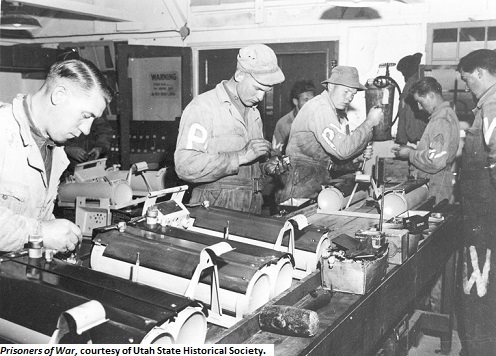Dublin Core
Title
Description
Many people know about the Japanese internment camp Topaz, but Utah also held Italian and German prisoners of war during World War II.
As World War II raged throughout Europe and Japan, captured enemy soldiers were sent to the United States and Utah for internment. At its height, nearly 426,000 German and Italian soldiers were interned in the United States. In Utah, prisoners of war were placed in camps located at the Naval Supply Depot in Clearfield, the Deseret Chemical Warfare Depot, Hill Field in Layton, Tooele, Utah Army Service Forces Depot in Ogden, Bushnell General Hospital in Brigham, Dugway Proving Grounds, Logan, Orem, Tremonton, and Salina. Prisoners deemed subversive were sent to Ft.Douglas.
German and Italian prisoners of war worked five to six days a week for eight to ten hours near their site of imprisonment. In areas like Salina, where prisoners worked the sugar beet fields, they bolstered the local labor force bereft of young men and women serving in the war. POWs were typically paid $.80 (cents) a day for their labor.
The War Department allowed Italian and German POWs to begin their own orchestras, provided schooling, played movies, and, in general, attempted to acculturate the prisoners to the American democratic system. When Italy capitulated in September 1943, the Italian soldiers who signed an Italian Service Unit parole agreement were allowed weekend leave from their camps.
The War Department did little to interrogate the prisoners beyond the basic name, rank, and serial number. They also guaranteed the same amount of rations to be given to the prisoners as to the soldiers of the U.S. military, at least during the duration of the war. Some prisoners even married local women.
In 1967, Ralph Busco and Douglas Alder sent surveys to former German POWs imprisoned in Utah with such questions as, “How would you describe the conditions of life?”, “How was the food?”, and “Have you ever been treated brutally or inhumanly in America?” Of those who replied, most reported that they were treated fairly and that their stay in Utah was good.
Creator
Source
Image: Prisoners of War, c. 1939-1945. Prisoners of War working at Camp Ogden Army Service Forces. Courtesy of Utah State Historical Society.
_______________
See Ralph A. Busco and Douglas D. Alder, “German and Italian Prisoners of War in Utah and Idaho,” Utah Historical Quarterly 39 (Winter 1971): 55-72. Also see Ralph A. Busco’s Research on German and Italian POWs in Utah and Idaho, MSS 134, Special Collections and Archives, Utah State University, Logan, Ut.

